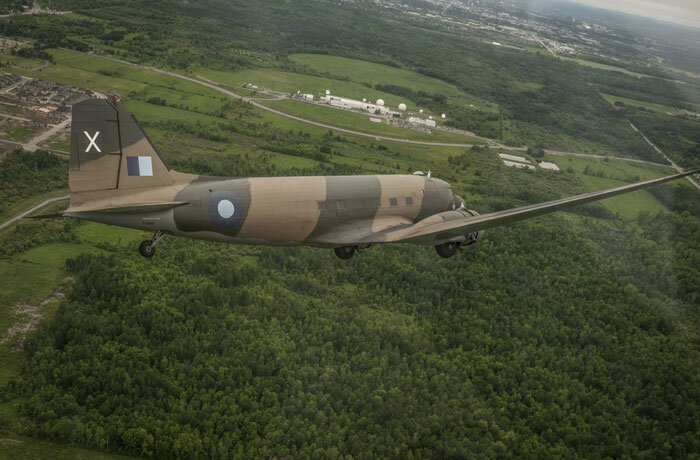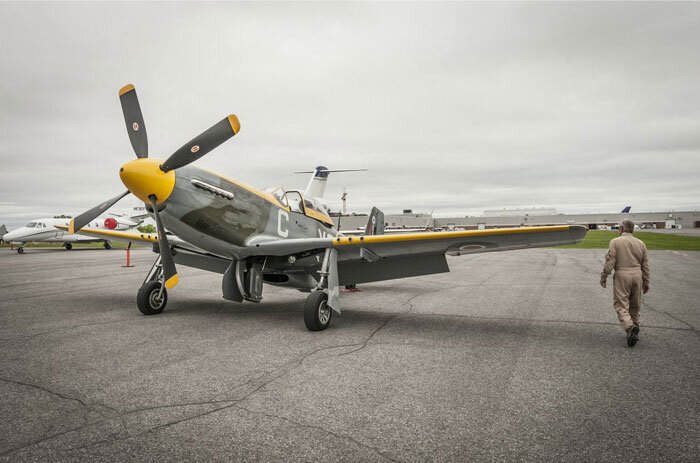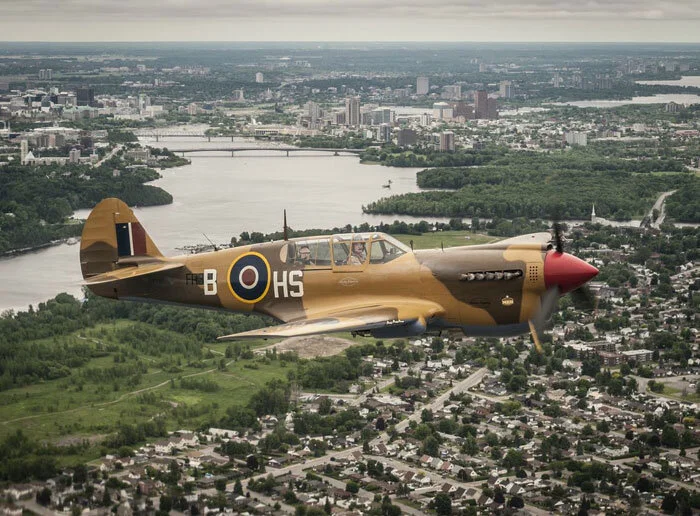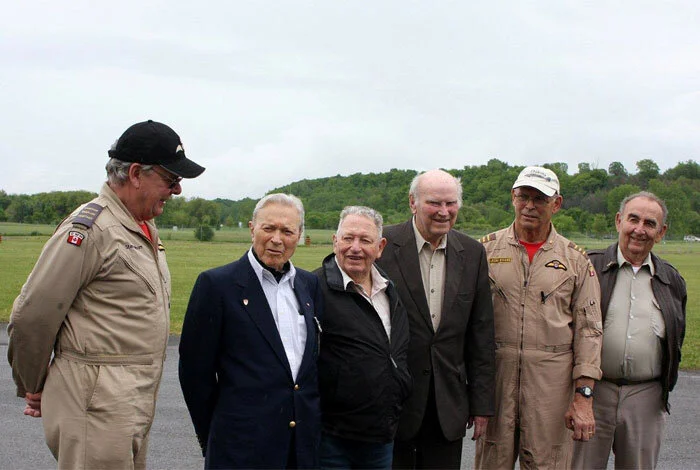OPERATION OVERLORD ESCORT
It’s been a few months since the 70th anniversary of D-Day. On that day, 70 years ago, Allied soldiers, sailors and airmen pulled off one of the most complicated battle plans ever devised. Now, three months later, we offer up a view of a very special day and the men we were honoured to honour.
Seventy years ago, Canadian, British and American troops were pushing across Belgium, Holland and the remnants of occupied France, with the Germans backed up to the Fatherland. Roosevelt and Churchill were so positive about the outcome, they were meeting at the Château Frontenac in Québec City to discuss the strategy for the defeat of Japan.
The Germans may have been reeling backwards, but they were far, far from done. There was still half a year of dying still to be done and much of Germany to be laid waste. Soon, Canadian ground forces and their RCAF brothers were beginning a sweep through Holland. Hawker Typhoon pilots of the RCAF and the RAF were as much a part of this massive and deadly ground war as a mortar or machine gun team on the ground. While their Spitfire- and Mustang-flying brothers were duelling with the Luftwaffe in the thin blue air at altitudes where they chalked contrails like a football playbook and while their Bomber Command brethren steeled their hearts on a steady course through clouds of flak and the raking fire of night fighters, the ground attacking Typhoon pilots engaged an enemy without wings.
Typhoon pilots added to the lethal threats of flak and enemy fighters, a buffet of dangers that made their life expectancy one of the shortest in the air war—small arms fire, collision with terrain, heavy machine guns from armoured vehicles and tanks, and bad weather. The Typhoon was designed to be a super powerful and lethal air superiority fighter for the mid-level air war. At the altitudes it was designed for (above 15,000 feet), it lacked the promised performance. Instead, at low levels, it performed better than its Spitfire and Hurricane stablemates. Displaying speed and agility, combined with size, stability and armour, the Typhoon became a fighter match for the Focke Wulf FW-190 as well as one of the finest ground attack aircraft of the Second World War.
Pilots who flew the Hawker Typhoon rightly consider themselves part of an elite... in the same way United States Marines see themselves—tough, rugged, muddy, and sharing with ground troops the deprivations of life near the front and immediate threats of counterattacks. They conducted their business at the front, close to the ground fighting, and they fought the Wermacht as well as the Luftwaffe.
Lorem ipsum dolor sit amet, consectetur adipiscing elit, sed do eiusmod tempor incididunt ut labore et dolore magna aliqua. Ut enim ad minim veniam, quis nostrud exercitation ullamco laboris nisi ut aliquip ex ea commodo consequat. Duis aute irure dolor in reprehenderit in voluptate velit esse cillum dolore eu fugiat nulla pariatur. Excepteur sint occaecat cupidatat non proident, sunt in culpa qui officia deserunt mollit anim id est laborum.Lorem ipsum dolor sit amet, consectetur adipiscing elit, sed do eiusmod tempor incididunt ut labore et dolore magna aliqua. Ut enim ad minim veniam, quis nostrud exercitation ullamco laboris nisi ut aliquip ex ea commodo consequat. Duis aute irure dolor in reprehenderit in voluptate velit esse cillum dolore eu fugiat nulla pariatur. Excepteur sint occaecat cupidatat non proident, sunt in culpa qui officia deserunt mollit anim id est laborum.Lorem ipsum dolor sit amet, consectetur adipiscing elit, sed do eiusmod tempor incididunt ut labore et dolore magna aliqua. Ut enim ad minim veniam, quis nostrud exercitation ullamco laboris nisi ut aliquip ex ea commodo consequat. Duis aute irure dolor in reprehenderit in voluptate velit esse cillum dolore eu fugiat nulla pariatur. Excepteur sint occaecat cupidatat non proident, sunt in culpa qui officia deserunt mollit anim id est laborum.
Lorem ipsum dolor sit amet, consectetur adipiscing elit, sed do eiusmod tempor incididunt ut labore et dolore magna aliqua. Ut enim ad minim veniam, quis nostrud exercitation ullamco laboris nisi ut aliquip ex ea commodo consequat. Duis aute irure dolor in reprehenderit in voluptate velit esse cillum dolore eu fugiat nulla pariatur. Excepteur sint occaecat cupidatat non proident, sunt in culpa qui officia deserunt mollit anim id est laborum.
One look at the massive Hawker Typhoon from this angle and you understand why it struck fear into the hearts of German tank crews and infantry. It has all the appearance of a Great White Shark about to take a chunk out of its prey. Here, ground crews using hand cranks, upload 500 pound bombs to the wings of a “Tiffy” loaded for bear sometime on or after D-Day, as witnessed by the black and white invasion stripes. Along with the Russian-built Ilyushin Il-2 Sturmovik, it was the most successful ground attack fighter of the Second World War. Photo: RAF
This past June 6th, on the 70th anniversary of Operation Overlord—the invasions of Normandy known by all as D-Day—three of Canada’s premier aviation heritage institutions combined to honour those Hawker Typhoon pilots whose exploits are now legendary. The Canada Aviation and Space Museum (CASM), the country’s premier collection of historic aircraft, under the leadership of Stephen Quick, worked with the RAF Museum at Hendon, England to accept on loan, the world’s only complete example of a Hawker Typhoon. The one of a kind aircraft began a two-year-long stay on display at the CASM’s Rockcliffe museum facility, painted in the markings of the RCAF’s storied 440 Squadron, the Vampires.
Of the idea, Stephen Quick writes: “This story started as a dream and a late night conversation with the then Director of the RAF Museum over wine three years ago to bring the world's only Tiffy to Canada and honour the men that flew them in such a hostile battle environment. Everyone gave of their time and their dedication to make this happen from the huge hearted Michael Potter, to the amazing Dave Rohr from Canadian Warplane Heritage, my fabulous crew at the Museum, the boys at RAFM, the RCAF and the incredible pilots and crews that flew on June 6th 2014. Gentlemen, for one brief shining moment you gave these Typhoon pilots the thank you they deserve. They are men who gave so much to their country and never asked for anything in return. When they came off of the DC3 that day they were saluted as heroes coming home. We must never forget, they were young men who stood fast for everything we are today, a great country where amazing men and women move mountains and still say, "I was just doing my job". I humbly say thank you to everyone that made this happen.”
To commemorate the start of the Typhoon’s stay in Canada and the 70th anniversary of Operation Overlord, the CASM called upon the Canadian Warplane Heritage Museum and Vintage Wings of Canada. The idea was to have a group of honoured D-Day veteran Typhoon pilots arrive in style at a public “unveiling” ceremony for the Typhoon—in a vintage DC-3 Dakota similar to those used in the D-Day invasions. A group so honoured should also be escorted in the air, so that those on the ground in Ottawa who might see them would know that something very special was flying overhead on what, for most, would just be another working day. Vintage Wings of Canada was called upon to provide the escort in the form of two Second World War fighters.
The first choice for escort duty would have been aircraft types that had participated alongside the Hawker Typhoon in Operation Overlord and the subsequent defeat of the Nazis—a Supermarine Spitfire and a P-51 Mustang perhaps. Unfortunately, and luckily for me, the Vintage Wings Spitfire was unserviceable. This made the next choice for escort duty the P-40 Kittyhawk. Though no Curtiss Kittyhawks took part in the closing battles on the Western Front, it was dedicated to a man who certainly did—Wing Commander Stocky Edwards. During its restoration, and under the direction of Vintage Wings, Pioneer Aero of Auckland, New Zealand installed a second seat and set of controls.
Related Stories
Click on image
The Vintage Wings of Canada 442 Squadron P-51 Mustang was also chosen and this was particularly appropriate, for 442 worked side by side with Typhoon units as they swept inexorably across France and the Lowlands towards Germany. The Vintage Wings aircraft is dedicated to two brothers from Ottawa who took part in the aerial battles throughout Nazi-occupied Europe—Flying Officer Laurent “Larry” Robillard and younger brother Roger, known to all as “Rocky”.
Larry Robillard would become an ace with 7 1/2 kills, flying for many squadrons including in the RAF and RCAF 145, 72, 130, 402, 411, 442, and 443. With 145 Squadron while on a sweep over Lille, France after D-Day, he was shot down. Being French speaking, he was able to evade capture and return to flying in England via Spain and Gibraltar.
It was Larry’s little brother Roger or “Rocky” who had the longest attachment with 442 Squadron and who flew the Mustang on ops in Europe. In fact, Rocky flew a Mustang with RCAF Serial, KH661 (the aircraft represented by the Vintage Wings Mustang) many times while pushing the Germans further and further back towards Berlin at the end of the war. Rocky would share the destruction of one enemy aircraft with another 442 Squadron pilot. Rocky flew Kittyhawks in the Aleutians and the west coast and was transferred to Britain in late 1943 at the age of just 19 to form the new 442 Squadron.
Vintage Wings pilots Rob Erdos (left) and Mike Potter (right) brief the flight with Dakota pilots of the Canadian Warplane Heritage Museum (CWHM)—Chief Pilot Leon Evans and Sten Palbom. Also in the photo (second from left) is Matt Lundy. Photo: Annette Koolsbergen
In the early morning of 6 June 2014, 70 years to the day that Canadian boys were fighting their way through the cobbled streets of Courseulles-sur-mer and Saint-Aubin-sur-Mer, and the Typhoon pilots of 440 Squadron were pounding the advancing German troops and armour through a hailstorm of ground fire, I found myself in the back seat of a Second World War fighter aircraft snugged into the left wing of a big DC-3 as it flew on currents of Canadian air. Across from us on the Dak’s right wing flew the legendary P-51 Mustang and two friends.
We were four very lucky Canadians, Mike Potter, Rob Erdos, Peter Handley and me—able to pay homage to a group of Canadian heroes with aircraft dedicated to other heroes. I could not imagine a better place to be—flying over the Nation’s Capital, with four close friends, in two fighters from another time, escorting a group of men who made all this possible. Sitting in the back behind Rob, I could feel the greatness carried in that DC-3, watch her big rudder flick, her engines thunder as she proudly carried those great once young men who gave us so much. For me, it’s never too late to share that day, so here you are... honouring the Typhoon pilots of D-Day.
Mike Potter in The Robillard Brothers P-51D Mustang and Rob Erdos in The Stocky Edwards P-40N Kittyhawk show two thumbs up, indicating they are good to go. They will keep the thumbs up until acknowledged by co-pilot Sten Palbom in the cockpit of the Dakota. Photo: Annette Koolsbergen
Mike Potter swings in behind the Canadian Warplane Heritage Museum’s DC-3 Dakota as she begins her roll down Runway 27. This particular DC-3 never saw combat, having been built in 1939 for Eastern Airlines. In 1952, after 13 years with Eastern, it went to North Central Airlines, the former Wisconsin Central Airlines, which operated until 1963. The DC-3 flew commercially until acquired by Dennis Bradley, who then donated it to the Museum in 1981. This DC-3, painted as an RCAF Dakota, is one of the highest time DC-3s flying today. With over 82,000 hours in the air, the Dak has been aloft for about 9.5 years!—flying over 12 million miles, or the equivalent of 492 times around the world. Photo: Peter Handley
Shortly after takeoff, Potter slides in on the starboard wing of the Dakota. The CWHM DC-3 Dakota is painted in the markings of No. 435 and 436 Squadrons of the RCAF. The two squadrons were sent to Burma during the Second World War, operating under the nickname of “Canucks Unlimited”. The Dak carries the dark blue/light blue roundels of the South East Asia Command (SEAC). The official roundel of the SEAC was the elegant dark blue/light blue roundel, which was used by units under South East Asia Command and in the China Burma India (CBI) theatre mid-1942–1946. As with earlier SEAC roundels, the red was removed to avoid confusion with the hinomaru. Initially, as in the case of the RAAF units, the red was overpainted with white but this compromised the camouflage and the normal roundel blue was mixed 50:50 with white. Many aircraft in the CBI theatre used roundels and fin flashes of approximately half the normal dimensions, perhaps because the amount of white in the normal sized roundels, when seen against a dark green jungle canopy, was too obvious to the enemy above. Photo: Peter Handley
Looking across the wing of the Mustang, Handley captures the Stocky Edwards P-40 sliding into the left wing, as the Dakota leads the formation down the Ottawa River on the way to downtown Ottawa. Photo: Peter Handley
From the starboard side of the Dakota, CWHM photographer Annette Koolsbergen shows just how tight the formation was. Mike Potter is locked on his formation reference points and cannot enjoy the view at all, while Peter Handley machine guns away from the back seat. Photo: Annette Koolsbergen
Over downtown, Vintage Wings pilot Rob Erdos, with Dave O’Malley as ballast, slides in close to the Dak and Koolsbergen’s camera. Photo: Annette Koolsbergen
Having skirted the downtown area in a counter-clockwise circuit, the formation heads to a flypast of Parliament Hill. Here we see the P-40 over the University of Ottawa football field, with the Rideau River snaking by. Photo: Peter Handley
Downtown Ottawa sits under a hazy and glowering sky as Leon Evans and Sten Palbom lead us toward Parliament before heading to the Ottawa International Airport. Photo: Peter Handley
Setting up on the crosswind leg, Evans brings the Dak close to Canadian Forces Station Leitrim (seen above fuselage), Canada’s oldest operational signal intelligence collection station. Established by the Royal Canadian Corps of Signals in 1941 as No. 1 Special Wireless Station and renamed Ottawa Wireless Station in 1949, CFS Leitrim acquired its current name in 1966. Today, 480 military and civilian work there collecting and analyzing radio and other communications from around the world. Photo: Peter Handley
After the Dakota and P-40 landed at Ottawa International, Potter breaks and looks for the field to begin his let down. Photo: Peter Handley
In the Esso Avitat FBO, veteran Typhoon pilots were catching up with each other as they assembled before boarding the Canadian Warplane Heritage Museum’s Dakota, which awaits in the background. Photo: Peter Handley
Flight Lieutenant John Brown Friedlander, a Typhoon pilot with 181 Squadron RAF, greets an old friend at the Esso Avitat. Photo: Peter Handley
At the Esso Avitat FBO lounge, Mustang pilot and Vintage Wings of Canada founder Mike Potter stops to speak to an old friend—Flying Officer Ken Hanna, DFC of Ottawa. Ken was born in Prescott, Ontario on the St. Lawrence River, growing up in nearby Brockville in Loyalist country. Ken, an apprentice tool and die maker by trade, joined the RCAF in 1941. Ken flew Hawker Typhoons with the Royal Air Force’s 181 Squadron. This unit operated their Typhoons from several RAF airfields in England including RAF Snailwell, RAF Odiham and RAF Hurn. They were involved in operations against V-1 Buzz Bomb launch sites and in support of the D-Day landings. Following D-Day, they relocated behind the lines and followed advances across Europe and into Germany, seeking ground targets of opportunity. The citation that accompanied Hanna’s Distinguished Flying Cross reads: “This officer has completed a large number of varied sorties, including many armed reconnaissances over the battle area in the West. He has displayed a high standard of leadership, skill and courage and has contributed materially to the success of the squadron. In December, 1944, he flew one of a formation of aircraft detailed to attack enemy vehicles in the Saint-Vith area. In a most spirited engagement two tanks and 12 mechanical vehicles were destroyed. Throughout, Flying Officer Hanna set a fine example by his skill and resolution.” For an interesting video of Hanna speaking about some of his personal experiences, click here. Photo: Peter Handley
Flight Lieutenant Ken Hanna chats with an FBO attendant as he leads the group of Typhoon pilots out to the DC-3. Photo: Peter Handley
Heading out to the Dak and another date with history, the Typhoon veterans looked pretty proud. Photo: Peter Handley
Potter walks back to the Mustang to prepare for the escort portion of the flight. The Mustang is primped and polished for this honourable flight, but 70 years ago, the Typhoons of the RCAF and RAF would have been mud-splattered, oil-stained and patched. Photo: Peter Handley
Photographer Handley, squeezed into the rear seat of the Mustang, captures Mike Potter hooking up his parachute harness before firing up the aircraft. This day, only the four men in the escort aircraft would require parachutes, with the veteran fighter pilots borne aloft in relative and very deserving comfort. Photo: Mike Potter
CWHM Dak pilots Leon Evans and Sten Palbom have both engines warmed up nicely on the ramp at Ottawa International Airport. Photo: Peter Handley
The three-ship formation thunders over the City of Gatineau with Ottawa off their port wings. Below, people were no doubt curious as to what was the special event and if they paused to think what day it was, they would no doubt connect the aircraft with some sort of D-Day memorial. Photo: Peter Handley
Rob Erdos and Dave O’Malley pass to the northwest of Parliament Hill. The honoured guests in the Dakota were provided with a first class view of the very place where war was declared in 1939 and where, on 6 June 1944, Prime Minister W.L. Mackenzie King confirmed to MPs that the Allied invasion of France was underway. King repeated his radio address from earlier in the day, along with messages from Supreme Commander Gen. Dwight Eisenhower and British Prime Minister Winston Churchill. King and Opposition Leader Gordon Graydon also discussed expediting parliamentary business in the wake of D-Day. Photo: Peter Handley
After escorting the Dak in a single flypast of the Canada Aviation and Space Museum, Rob Erdos and Mike Potter headed across to Gatineau and a short bit of formation practice. Here Rob slides in to Mike’s wing as they cross into suburban Gatineau coming out of Rockcliffe. Photo: Peter Handley
As Potter banks, Erdos rides up in the turn on a grey but easy flying day. Photo: Peter Handley
The two-ship heads back to Gatineau. Photo: Peter Handley
At the Canada Aviation and Space Museum, the crowd awaits the arrival of the veterans, some of whom probably had never seen a Typhoon since the war was over. Photo: Olivier Lacombe
At the Canada Aviation and Space Museum at Rockcliffe, the two escorting fighters broke away and let the Dakota do a solo pass on its own for the crowds below. Photo: Olivier Lacombe
On the ground at Rockcliffe. Kudos to the dedicated volunteer crew of the Canuck’s Unlimited Douglas DC-3 Dakota from Canadian Warplane Heritage Museum—Left to right: Craig Brookhouse, Heinz Hormann, Leon Evans, Sten Palbom and Matt Lundy. Photo: Annette Koolsbergen
Flight Lieutenant Bob Spooner DFC clearly enjoying the event at the Canadian Aviation and Space Museum at Rockcliffe. Spooner, a 438 Squadron Typhoon pilot during the Second World War, was awarded the Distinguished Flying Cross and was gazetted after war’s end, in July 1945. The impressive citation accompanying his DFC reads: “Since September 1944, this officer has completed numerous operational sorties including many low level attacks against heavily defended enemy transport, canal locks, railway sidings and bridges. On one occasion, Flight Lieutenant Spooner’s aircraft was hit by the flying debris of an exploding ammunition train. Despite this and intense anti-aircraft fire from the enemy’s defences he pressed home his attack on the remaining targets. As a flight commander this officer has always displayed brilliant leadership and a fine fighting spirit. This was particularly evident during the German offensive around Saint-Vith when he led his squadron on a number of low level attacks against heavily defended enemy transport convoys.” Photo: Annette Koolsbergen, inset photo of Spooner from FlyingForYourLife.com
Flight Lieutenant Bob Spooner poses with his old warhorse, the Hawker Typhoon. Spooner, a native of Victoria, British Columbia joined the RCAF in 1941. He did his Elementary Flying Training at No. 5 EFTS High River, Alberta, then his Service Flying Training at No. 10 SFTS, Dauphin, Manitoba. After getting his wings, he did a stint as an instructor pilot, returning to High River. Spooner wears his 438 Squadron Wildcat badge on his blazer. The motto of 438 Squadron is “Going Down”, the words often spoken by a Typhoon flight commander as he leads his men down for an attack. Photo: Annette Koolsbergen
Craig Brookhouse of the Canadian Warplane Heritage Museum stands with Flight Lieutenant John Brown Friedlander, DFC. Friedlander was an RCAF Typhoon pilot with two RAF squadrons, 181 and 247. He wears the badge of 181 Squadron on his blazer. For an interesting video of Friedlander speaking about his experiences on Typhoons at The Vimy Memorial in France, click here. Photo: Annette Koolsbergen
D-Day veteran Typhoon pilots Flight Lieutenant John Friedlander, DFC, Flying Officer Angus Scott and Flying Officer Harry Hardy, DFC, join members of the Dakota crew for a group shot. Friedlander’s story is covered in the previous photograph. Harry Hardy was a typhoon pilot with 440 Vampire Squadron of the RCAF, flying a total of 96 ops from D-Day to the crossing of the Rhine. He named his aircraft Pulverizer and he must have lost a few aircraft through combat damage as the last one was called Pulverizer IV. For a fascinating video of Hardy relating his personal experiences and sharing his personal photographs from the war, click here and here. Angus Scott also flew with 440 Squadron RCAF. Photo: Annette Koolsbergen
Harry Hardy taxies his 440 Squadron Typhoon Hawker Typhoon, “P” for Pulverizer, over steel matting at a forward airfield in Eindhoven, Holland in 1944-45. The Typhoon now on display at the CASM is painted in 440 Squadron markings. 440’s squadron code was I8 (Letter “I”, Numeral 8). Photo: Imperial War Museum
Flight Lieutenant Ken Hanna and Flight Lieutenant John Friedlander smile for paparazzi at the Canada Aviation and Space Museum. Photo: Annette Koolsbergen
Friends and family gather round the Dakota to greet the RCAF heroes of D-Day. Photo: Annette Koolsbergen
The only complete Hawker Typhoon in the world today has been brought to the Canada Aviation and Space Museum in Ottawa. For the next two years, it will become one of the most asked for and photographed exhibits at the world-class facility. Prior to being put on display, the Tiffy was painted in the makings of I8-T, a 440 Vampire Squadron Typhoon. Photo: Greg Brooks, www.flickr.com/photos/ottcan_520/.
Compare this photo with the first photo of a Typhoon from 1944—still looking impressive and deadly after 70 years. Photo: Greg Brooks, www.flickr.com/photos/ottcan_520/












































